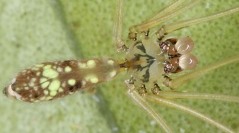

 European Journal of Taxonomy
2016 (190) - Pages 1-55 (EJT-190)
European Journal of Taxonomy
2016 (190) - Pages 1-55 (EJT-190)The Southeast Asian Pholcus halabala species group is revised and re-delimited, based mainly on field observations (life color pattern, web design, position of egg-sac when carried by female, microhabitat) and ultrastructure (silk spigots, modifications of male cheliceral apophyses). The core group includes six leafdwelling species that have distinctive color patterns in life specimens (black and white or yellowish abdominal marks, dark pattern on posterior half of carapace) and build round to oval silk platforms on the undersides of leaves. Seven further species are tentatively assigned to the group pending further study. Several species originally assigned to the Pholcus halabala group are transferred to three newly proposed species groups, the Ph. krabi, Ph. buatong, and Ph. andulau groups. Nine species are newly described, four in the Ph. halabala group (Ph. khaolek Huber, sp. nov.; Ph. kuhapimuk Huber, sp. nov.; Ph. lintang Huber, sp. nov.; Ph. ubin Huber, sp. nov.); three in the Ph. krabi group (Ph. kipungit Huber, sp. nov.; Ph. krabi Huber, sp. nov.; Ph. narathiwat Huber, sp. nov.); one in the Ph. buatong group (Ph. buatong Huber, sp. nov.); and one in the Ph. andulau group (Ph. lambir Huber, sp. nov.). The females of Ph. satun Huber, 2011 and Ph. schwendingeri Huber, 2011 (both members of the buatong group) are newly described.
Pholcus, taxonomy, web design, microhabitat, ultrastructure.